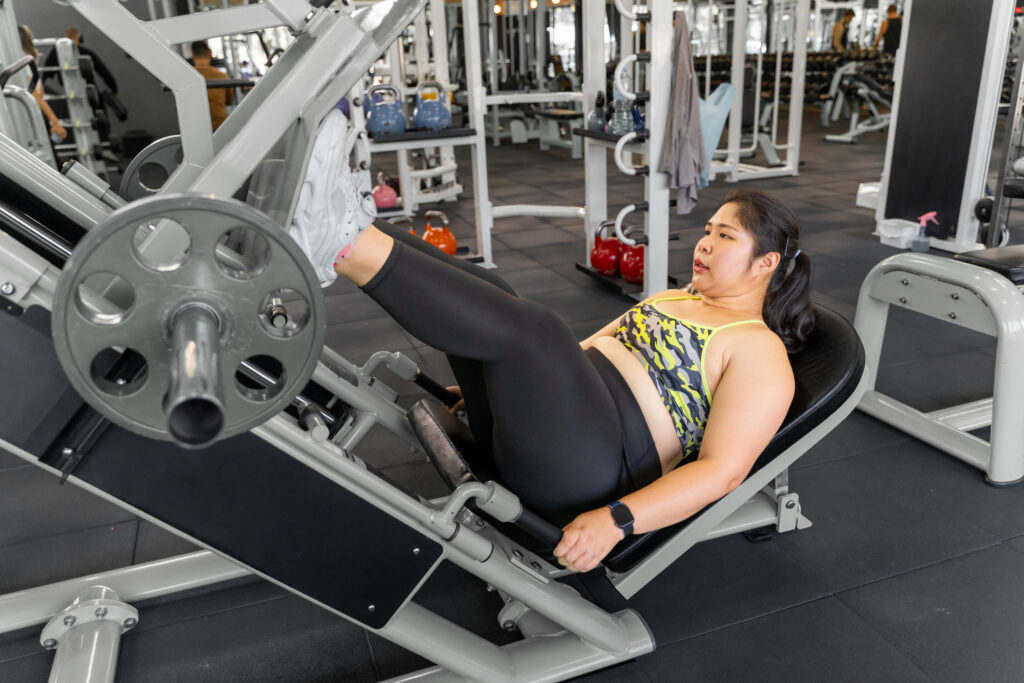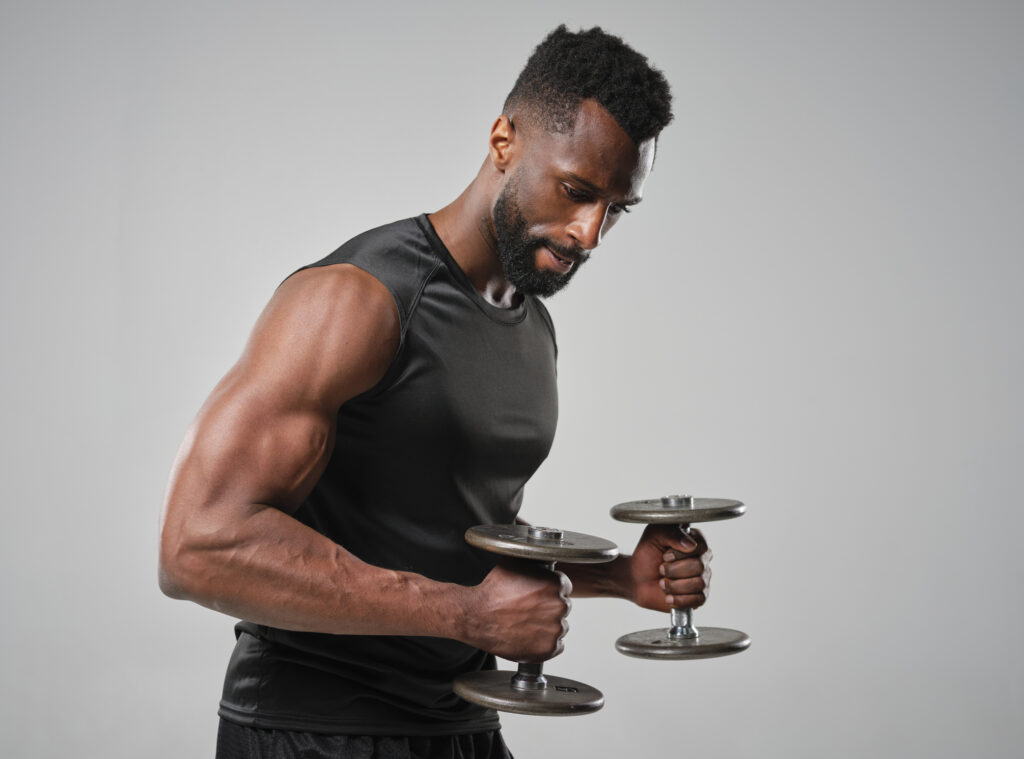The world of strength building is teeming with myths and bad Instamation from oily, jacked dudes on that social platform promising to get you from cushy to cut in six weeks.
For years, chief among the myths were “You’ve got to break the muscle down to get stronger,” and “The heavier the weight, the stronger you’ll get and faster.” Neither of those is true. Nor is the assumption that muscles must be large to be strong.
To sort fact from fiction and understand how lighter weights can produce the same strength results as heavier weights, Health & Wellness talked to Marily Oppezzo of Stanford University. In addition to being an exercise interventionist, Oppezzo, who earned her graduate and doctorate degrees from Stanford, is a dietitian, behavioral and learning scientist and the head of the nutrition pillar at Stanford Lifestyle Medicine.
Oppezzo said three verbs hold the key to getting stronger with lighter weights. Load. Challenge. Progress (as in progression, not progress report). Notice the absence of “reps.” There’s a reason for that.
Load
Muscles are really long cells that resemble strings, which cross joints and attach to bones in two different places, Oppezzo explained, to establish how they function and their relationship to bone density.
With movement and exercise, “if you keep having muscle do the same thing, then it doesn’t have to make any changes. Muscle doesn’t need to grow thicker fibers or longer fibers if it’s fine doing what it’s doing,” Oppezzo said. “But if you give it a new stimulus or more stimulus, then it goes, ‘Oh, shoot! I’ve gotta remodel this.”
Enter load. And enter myth – because load does not equal heavier weight. Load is the stimulus that alerts the muscle to change, allowing it to keep up with the demands of the activity.
“Load can be range of motion,” Oppezzo said. For example, a shallow squat does not require as many muscle fibers to return to a standing position as a deeper one does .
There is a ceiling on the human body. You can’t keep increasing weight. ~ Marily Oppezzo, Stanford University. exercise interventionist
“Hamstrings and glutes are in a more stretched position if I’m lower. So that’s another way to increase load without increasing weight,” Oppezzo explained. “It’s just pulling and recruiting more fibers to engage and more fibers to get stronger.
That recruitment and engagement cause microscopic tears in the muscle. “Break it down is an old term, like saying you’ve got to tear it. You don’t actually tear it,” Oppezza said. (A torn muscle would require treatment ranging from ice and elevation to physical therapy, and possibly even surgery.) “There are microtears. But what’s really happened is that you’ve challenged it in a way that it has to physiologically adapt.”
Other forms of adding load to induce muscle to adapt include incorporating a resistance band and slowing the tempo of the lift or exertion. Going slower “means your muscle has more time under tension in one rep.” Oppezzo said.

Demanding something new of muscle by increasing tension or adding stress is what produces strength. That’s different from an increase in muscle size, which is called hypertrophy. Strength refers to how much force a muscle can produce or exert, not how large it is.
Strength can make muscles bigger, Oppezzo said, but being strong doesn’t require bodybuilder-sized pecs, hamstrings and biceps. However, “strength and hypertrophy are not necessarily different,” she explained. You can get stronger and bigger. And you can get stronger and not get bigger. I’m not sure you can really get only bigger and not stronger.”
Challenge
As you increase load by going lower or slower, it’s essential to challenge your muscles to increase strength without increasing weight. An adequate challenge hinges on effort and failure.
“You have to get to a point where your muscles are like, ‘Oh, Dude! I can’t do that. I gotta figure this out,” Oppezzo said. The point where muscles cry, “Uncle,” is called the last set to failure.
It’s when the muscle you’re working is exhausted. It can no longer do the activity, or it cannot keep the form necessary to make the exercise effective. However, you need to be attuned and aware of which part of you is failing.
“At a certain point, when you have only one to two reps left in reserve, it’s what your muscles can do,” Oppezzo emphasized. “It’s not what your brain or heart can do. So, if I’m cardiovascularly exhausted from doing 55 reps, that’s my heart saying, ‘I’m done,’ not my muscle. Or maybe my brain wants to quit after 18 reps, but my muscle won’t. You gotta figure it out for you. When do your muscles have only one rep, not your willpower or your heart.”
A Word About Reps
While you might have heard that the secret to getting stronger with lighter weights is to increase reps, that’s only part of the equation. The objective is exhaustion, not a number.

“When you give people reps as a goal, they try to use their body to get to the number,” Oppezzo said. “It’s better to use reps as a feedback mechanism. If last time it took me 12 reps to get to having only one or two in reserve, and this time it took me 15 reps to get there, then maybe I should go up in weight if I don’t want to keep adding reps. Reps are better to be used as feedback than a goal.”
That leads to the third strength-building factor.
Progression
It’s been said that if you do what you’ve always done, you get what you’ve always gotten. And that’s rarely the objective of gaining and maintaining strength.
“You have to have the concept of progressive overload. You have to progressively keep challenging the muscle and keep adding over time,” Oppezzo advised. “You don’t have to overload with weight. You can overload with a shorter rest time between sets. You can overload with more time under tension. You can overload by adding a day.”
And if the overload is to add another set, the objective remains working to just shy of the point of failure, not just adding a set.
Some Final Words
Going heavier isn’t the only path to getting stronger. Lighter weights can increase strength by: increasing and changing load, not necessarily weight; challenging yourself by honing in on what your muscle can do, not your heart or mind; and by switching it up.
Oppezzo suggests variation. Find a new way to work the biceps or legs. “And then come back to that original exercise,” she said. “Maybe you can increase and do more, or maybe not. There is a ceiling on the human body. You can’t keep increasing weight. It’s not a linear thing.”



